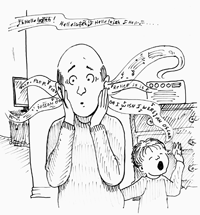STRANGE BUT TRUE- Brainworms: As old as the sands of time

DRAWING BY DEBORAH DERR McCLINTOCK
Q. In his 1876 story "A Literary Nightmare," Mark Twain described his narrator as rendered helpless by his obsession with certain jingle rhymes: "They took instant and entire possession of me. All through breakfast they went waltzing through my brain... Presently I discovered my feet were keeping time to that relentless jingle... I jingled all through the evening, went to bed, rolled, tossed, and jingled all night long." What's behind today's epidemic of such "brainworms"? –V. Assar
A. Although brainworms are no doubt ancient, the term has come into common use only in the last few decades, probably because music is now ubiquitous, says neurologist Oliver Sacks in his book Musicophilia: Tales of Music and the Brain. Many of us are plugged into iPods, immersed in daylong concerts of our own choosing; and for everyone else, there's nonstop and unavoidable music in bars, restaurants, shops, and gyms.
Much of it is designed to hook the listener with "sticky" music or "catchy" tunes that bore their way like an earwig into the ear or mind: Think of the wordless themes of "Mission: Impossible" or Beethoven's "Fifth," or Alka Seltzer's ad "Plop, plop, fizz, fizz." Brainworms arrive unbidden, neurologically completely irresistible, and leave only in their own time.
Q. What's the physical force that most determines where the baseball pitcher must aim his pitch? And what's the point of the pitcher's mound anyway? –R. Maris
A. Without the pitcher's mound, the game would be plagued with pitches going into the dirt or bouncing off home plate, reports the National Baseball Hall of Fame. The force, of course, is gravity, which tugs every pitch and batted ball downward at an acceleration of 9.8 meters (32 feet) per second per second. Even the fastest pitcher's smokeball may drop by as much as 2 1/2 feet en route to the catcher. Here is where the pitcher's mound, by helping give the pitch extra elevation, is not only critical to the pitcher's performance but also to the greatness of the "grand old game." Gravity in control– now let's "Play ball!"
Q. Is hypnosis a marvelous psychological tool or mere fakery? –N. Reiner
A. Experts can't even agree if it's a bona fide altered state of consciousness or just a mood of relaxed suggestibility with subjects unconsciously playing along so as not to "spoil the act," says Dennis Coon in Introduction to Psychology: Exploration and Application.
Some 80 percent of people can "go under," but only half of these are "good hypnotic subjects," who can fantasize readily and focus attention inward. Subjects may report feelings of floating, sinking, separation from the body. Actions seem automatic, as if happening without effort.
Hypnotic fakery may be found on stage, but hypnosis is real, useful clinically for relaxation and to relieve pain, common in dentistry, or for easing childbirth. A hallmark of hypnosis is the altering of sensory experience. "Given the proper instructions, a person can be made to smell a small bottle of ammonia and respond as if it were a wonderful perfume," says Coon.
Especially bizarre is the "hidden observer": When subjects are directed to stick an arm into normally painful icy water, most will say they feel no pain. But if asked whether "some part of them" is feeling the pain, many say "Stop it! You're hurting me," as if split into separate
selves.
An easy test– from the Stanford Hypnotic Susceptibility Scale– is to stand with eyes closed while someone tells you you're starting to sway. If in fact you do sway, you're very hypnotizable.
~
Send Strange questions to brothers Bill and Rich at [email protected].
#